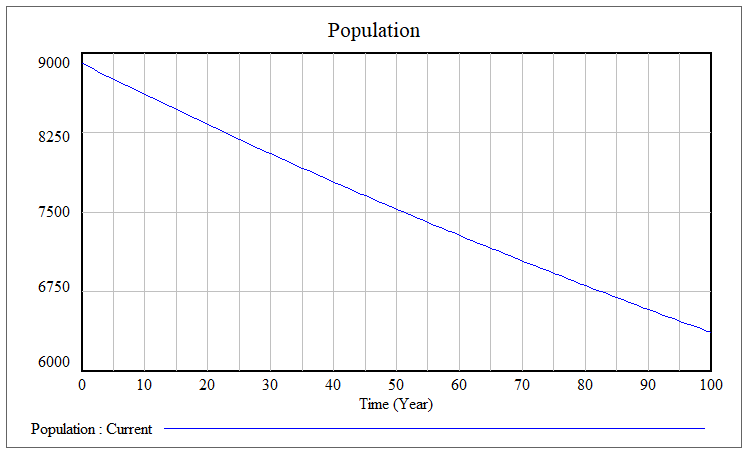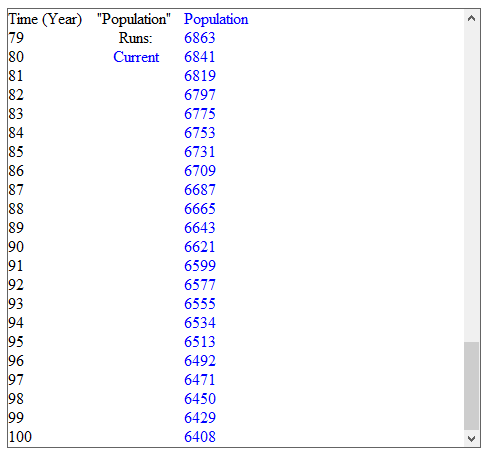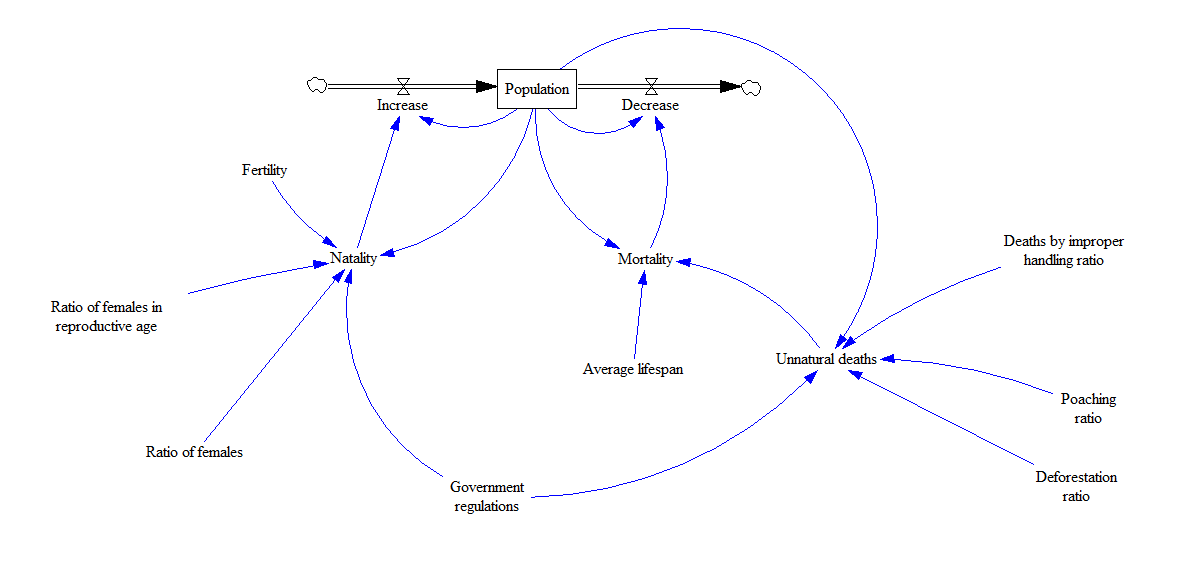Difference between revisions of "Indian Elephant Population in Thailand"
(→Model variables) |
|||
| Line 10: | Line 10: | ||
==Model variables== | ==Model variables== | ||
===Population=== | ===Population=== | ||
| − | Number of elephants in Thailand. Starting value 8900. This is the variable that we are examining. | + | Number of elephants in Thailand. Starting value 8900 <ref name="fao">ROGER, L. <i>The elephant situation in Thailand and a plea for co-operation</i>[online]. Available from: http://www.fao.org/3/ad031e/ad031e0r.htm </ref>. This is the variable that we are examining. |
===Increase=== | ===Increase=== | ||
Number of elephants that are born<br /> | Number of elephants that are born<br /> | ||
| Line 18: | Line 18: | ||
=Mortality*Population | =Mortality*Population | ||
===Natality=== | ===Natality=== | ||
| − | Ratio of newly born elephants to elephant population. Amount of newborn elephants equals fertility multiplied by number of females in reproductive age divided by 40*2 (number of reproductive years, multiplied by 2 as elephants pregnancy takes 22-24 months). We then multiply by Governement regualtion ratio. <br /> | + | Ratio of newly born elephants to elephant population. Amount of newborn elephants equals fertility multiplied by number of females in reproductive age divided by 40*2 (number of reproductive years, multiplied by 2 as elephants pregnancy takes 22-24 months). <ref name="reproduction"><i>Elephant Reproduction</i> [online]. Available from: https://www.elephant-world.com/elephant-reproduction/</ref> We then multiply by Governement regualtion ratio. <br /> |
=((Fertility*((Ratio of females*Population)*Ratio of females in reproductive age)/80)*Government regulations)/Population | =((Fertility*((Ratio of females*Population)*Ratio of females in reproductive age)/80)*Government regulations)/Population | ||
===Fertility=== | ===Fertility=== | ||
| − | Amount of calves a female is able to have during her reproductive lifespan. 40% of elephants' population lives in wilderness and the fertility is not affected by stress therefore a wild female is able to have 10 calves, and semi-domesticated female is able to have 7<br /> | + | Amount of calves a female is able to have during her reproductive lifespan. 40% of elephants' population lives in wilderness and the fertility is not affected by stress therefore a wild female is able to have 10 calves, and semi-domesticated female is able to have 7 <ref name="reproduction"/><br /> |
=0.4*10+0.6*7 | =0.4*10+0.6*7 | ||
===Ratio of females in reproductive age=== | ===Ratio of females in reproductive age=== | ||
| − | Elephant female can have calves during her 15 to 50 years.<br /> | + | Elephant female can have calves during her 15 to 50 years. <ref name="reproduction"/><br /> |
=0.5714 | =0.5714 | ||
===Ratio of females=== | ===Ratio of females=== | ||
| − | Ratio of females on elephants' population<br /> | + | Ratio of females on elephants' population<ref name="fao"><br /> |
| − | =53476 | + | =0.53476 |
===Government regulation=== | ===Government regulation=== | ||
Index of government regulations <0;1>, 1 means no government regulation<br /> | Index of government regulations <0;1>, 1 means no government regulation<br /> | ||
| Line 41: | Line 41: | ||
=((Deaths by improper handling ratio*Population)+(Poaching ratio*Population))*Government regulations + Population*Deforestation ratio | =((Deaths by improper handling ratio*Population)+(Poaching ratio*Population))*Government regulations + Population*Deforestation ratio | ||
===Deaths by improper handling ratio=== | ===Deaths by improper handling ratio=== | ||
| − | Ratio of deaths that happen due to unhuman behavior towards elephants and conditions they have to live in<br /> | + | Ratio of deaths that happen due to unhuman behavior towards elephants and conditions they have to live in<ref name="seaworld"><i>Longevity and causes of death</i> [online]. Available from: https://seaworld.org/animals/all-about/elephants/longevity/</ref><br /> |
=0.01685 | =0.01685 | ||
===Poaching ratio=== | ===Poaching ratio=== | ||
| − | Ratio of deaths that happen because of elephants being hunted either for skin, tusks or to capture young calve<br /> | + | Ratio of deaths that happen because of elephants being hunted either for skin, tusks or to capture young calve<ref name="seaworld" /><br /> |
=3.3e-05 | =3.3e-05 | ||
===Deforestation ratio=== | ===Deforestation ratio=== | ||
| − | Ratio of deforastation in Thailand, this has a close correlation to number of elephants as this the major factor affecting the population<br /> | + | Ratio of deforastation in Thailand, this has a close correlation to number of elephants as this the major factor affecting the population <ref name="forest"><i>Deforestation statistics for Thailand</i> [online]. Available from: https://rainforests.mongabay.com/deforestation/archive/Thailand.htm</ref><br /> |
=0.0035 | =0.0035 | ||
Revision as of 00:35, 21 January 2020
Contents
Problem definition
During the course of the 20th century, the population of indian elephants has decreased drastically, mostly due to a significant reduction of elephants' natural habitat, as well as decrease in utilization of elephants in logging industry and shift to a role of a tourist attraction. This model showcases the evolution of elephants' population in Thailand for upcoming 100 years.
Method
The vensim modelling tool was selected for the purpose of this simulation.
Model
Model variables
Population
Number of elephants in Thailand. Starting value 8900 [1]. This is the variable that we are examining.
Increase
Number of elephants that are born
=Natality*Population
Decrease
Number of elephants that have died
=Mortality*Population
Natality
Ratio of newly born elephants to elephant population. Amount of newborn elephants equals fertility multiplied by number of females in reproductive age divided by 40*2 (number of reproductive years, multiplied by 2 as elephants pregnancy takes 22-24 months). [2] We then multiply by Governement regualtion ratio.
=((Fertility*((Ratio of females*Population)*Ratio of females in reproductive age)/80)*Government regulations)/Population
Fertility
Amount of calves a female is able to have during her reproductive lifespan. 40% of elephants' population lives in wilderness and the fertility is not affected by stress therefore a wild female is able to have 10 calves, and semi-domesticated female is able to have 7 [2]
=0.4*10+0.6*7
Ratio of females in reproductive age
Elephant female can have calves during her 15 to 50 years. [2]
=0.5714
Ratio of females
Ratio of females on elephants' populationCite error: Closing </ref> missing for <ref> tag
=0.01685
Poaching ratio
Ratio of deaths that happen because of elephants being hunted either for skin, tusks or to capture young calve[3]
=3.3e-05
Deforestation ratio
Ratio of deforastation in Thailand, this has a close correlation to number of elephants as this the major factor affecting the population [4]
=0.0035
Results


As we can see, we can expect a continuous decrease in elephants' population in Thailand. By the year 2119 the elephants' population in Thailand should decrease by 2492 elephants.
Conclusion
In this simulation I created a functional model representing the evolution of elephants' population in Thailand. The results show continuous decrease over the course of following 100 years. However there is a room for improvements, like parameter deforestation ratio because nowadays the problem of deforestation is gaining on significance in general public eyes and this might lead into deforestation ratio decrease and potentially lead into elephants' population growth.
Code
References
- ↑ ROGER, L. The elephant situation in Thailand and a plea for co-operation[online]. Available from: http://www.fao.org/3/ad031e/ad031e0r.htm
- ↑ 2.0 2.1 2.2 Elephant Reproduction [online]. Available from: https://www.elephant-world.com/elephant-reproduction/
- ↑ Cite error: Invalid
<ref>tag; no text was provided for refs namedseaworld - ↑ Deforestation statistics for Thailand [online]. Available from: https://rainforests.mongabay.com/deforestation/archive/Thailand.htm
